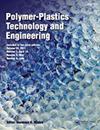废蛋壳源氧化钙和纳米羟基磷灰石生物材料制备LLDPE聚合物纳米复合材料及其热力学研究
Q2 Materials Science
引用次数: 32
摘要
利用废蛋壳制备氧化钙(E-CaO)和羟基磷灰石(E-HAP)。利用蛋壳热处理得到的E-CaO合成E-HAP。在Brabender塑形机上用线性低密度聚乙烯(LLDPE)熔融复合E-CaO/E-HAP,并将得到的配方研磨成型。在LLDPE中加入E-CaO/E-HAP可显著提高复合材料的阻燃性能和热稳定性。在对比研究中,E-HAP纳米粉末聚合物复合材料的热性能和力学性能都比E-CaO制备的复合材料有所提高。图形抽象本文章由计算机程序翻译,如有差异,请以英文原文为准。
Waste Eggshell-Derived Calcium Oxide and Nanohydroxyapatite Biomaterials for the Preparation of LLDPE Polymer Nanocomposite and Their Thermomechanical Study
ABSTRACT Waste eggshells were utilized to make calcium oxide (E-CaO) and hydroxyapatite (E-HAP). E-CaO obtained by heat treatment to eggshells was utilized for the synthesis of E-HAP. Melt compounding of E-CaO/E-HAP was performed with linear low-density polyethylene (LLDPE) on a Brabender Plastograph and ground the obtained formulation for injection molding. Addition of E-CaO/E-HAP in the LLDPE significantly enhanced the flame retardant ability and thermal stability of resultant composites. In the comparative study, E-HAP nanopowder-containing polymer composite showed increment in thermal and mechanical properties than the composite prepared using E-CaO. GRAPHICAL ABSTRACT
求助全文
通过发布文献求助,成功后即可免费获取论文全文。
去求助
来源期刊

Polymer-Plastics Technology and Engineering
工程技术-高分子科学
CiteScore
1.71
自引率
0.00%
发文量
0
审稿时长
4 months
 求助内容:
求助内容: 应助结果提醒方式:
应助结果提醒方式:


